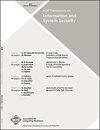安全协议物理特性的形式化推理
Q Engineering
ACM Transactions on Information and System Security
Pub Date : 2011-09-01
DOI:10.1145/2019599.2019601
引用次数: 48
摘要
传统的安全协议主要关注认证和密钥建立,依赖于预分布密钥和密码算子的属性。相比之下,新的应用领域正在兴起,这些领域建立并依赖于物理世界的特性。示例包括安全定位、距离边界和安全时间同步协议。我们提出了一个形式化模型,用于对此类物理安全协议进行建模和推理。我们的模型扩展了标准的、归纳的、基于痕迹的、符号的方法,将环境的物理属性(即通信、位置和时间)形式化。特别是,通信受到物理条件的限制,例如,消息的传输需要的时间取决于所使用的通信介质和节点之间的距离。包括入侵者在内的所有代理都受到这些约束,这导致分布式入侵者的通信能力比标准的Dolev-Yao入侵者受限,但更现实。我们已经在Isabelle/HOL中形式化了我们的模型,并使用它来验证身份验证测距、距离边界、基于延迟密钥披露的广播身份验证和时间同步的协议。本文章由计算机程序翻译,如有差异,请以英文原文为准。
Formal Reasoning about Physical Properties of Security Protocols
Traditional security protocols are mainly concerned with authentication and key establishment and rely on predistributed keys and properties of cryptographic operators. In contrast, new application areas are emerging that establish and rely on properties of the physical world. Examples include protocols for secure localization, distance bounding, and secure time synchronization.
We present a formal model for modeling and reasoning about such physical security protocols. Our model extends standard, inductive, trace-based, symbolic approaches with a formalization of physical properties of the environment, namely communication, location, and time. In particular, communication is subject to physical constraints, for example, message transmission takes time determined by the communication medium used and the distance between nodes. All agents, including intruders, are subject to these constraints and this results in a distributed intruder with restricted, but more realistic, communication capabilities than those of the standard Dolev-Yao intruder. We have formalized our model in Isabelle/HOL and have used it to verify protocols for authenticated ranging, distance bounding, broadcast authentication based on delayed key disclosure, and time synchronization.
求助全文
通过发布文献求助,成功后即可免费获取论文全文。
去求助
来源期刊

ACM Transactions on Information and System Security
工程技术-计算机:信息系统
CiteScore
4.50
自引率
0.00%
发文量
0
审稿时长
3.3 months
期刊介绍:
ISSEC is a scholarly, scientific journal that publishes original research papers in all areas of information and system security, including technologies, systems, applications, and policies.
 求助内容:
求助内容: 应助结果提醒方式:
应助结果提醒方式:


